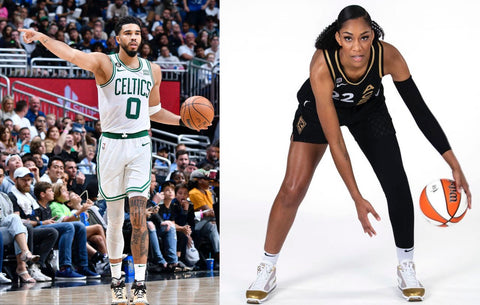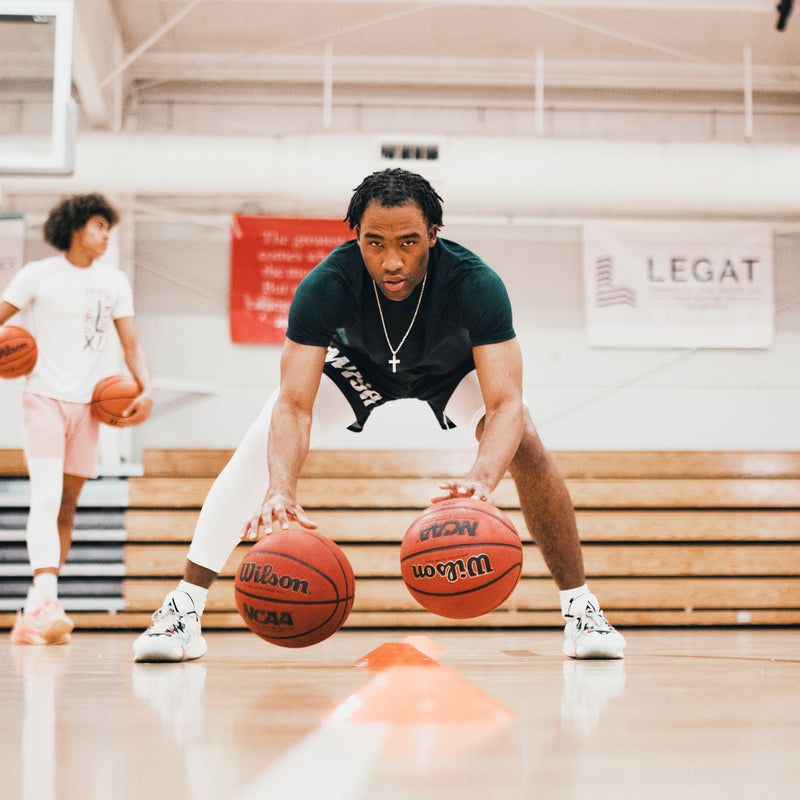If you turn on an athletic event or look at an athlete’s social media these days, you’re more than likely to see a wide range of clothing styles and in-game apparel that reveal a heavy fashion influence. What’s even more evident in today’s styles is the theme of asymmetry.
Athletes, with a growing influence from the fashion industry, are continually trying to find ways to stand out, boast their own unique styles, and take advantage of what has now become the pregame runway. Asymmetrical styles may not be blatantly obvious and have widespread popularity at the moment, but the trend has been on the rise for a few decades now and we’re betting it is just getting started.
A Brief History of Asymmetrical Sports Styles
Before we look at the multitude of cases where asymmetrical sports fashion is popping up today, let’s first take a quick glance back in time to see where this theme may have first begun.
Many athletes and sports fanatics can recall that Allen Iverson was the first to flaunt the shooting sleeve, but often don’t know the cause. In 2001, Iverson was suffering from bursitis in his right elbow and the Philadelphia 76er’s trainer, Lenny Currier, decided to cut the sleeve off a compression shirt to help lessen the pain. That night, on January 21st, 2001, Iverson dropped 51 points against the Toronto Raptors and the shooting sleeve was born. But was that the first sign of asymmetrical style in professional sports?
As a sophomore at UNC, a talented young basketball player named Michael Jordan started wearing an armband halfway up his forearm as a symbol of friendship for his teammate and roommate Buzz Peterson, who had suffered a knee injury earlier that year. Jordan continued to sport the look throughout his NBA career, thus ushering in another asymmetrical fashion accessory to athletes around the world. By 1996, athletes across multiple sports were wearing as many as four armbands around their biceps and forearms as fashion statements.
Like Iverson, Florence Griffith Joyner also found her way into sporting an asymmetrical style accidentally. Before her Olympic events in 1988, she was standing in front of a mirror, cut one leg off of her tracksuit, and actually liked how it looked. Throwing a pair of briefs on over the top, she went out and ended up promoting the first Single Leg Tights appearance in professional sports history.
So, was it the shooting sleeve and AI, the Single Leg Tights and Flo Jo, or MJ and the armband that first sparked the wave of asymmetrical accessories and styles? We may never know. But, what is easily distinguishable is that this trend of asymmetry has continued to evolve over time to become evermore popular across all sports and talent levels.
The Prevalence of Asymmetrical Styles in Sports Fashion
Instead of trying to prove a point through text, let’s first take a quick look at the multiple, often subtle, flashes of this asymmetrical theme within the sportwear industry that has blossomed beautifully from the days of MJ and AI.

Asymmetrically designed NBA game-worn shorts for the Memphis Grizzlies and Utah Jazz

Asymmetrically designed basketball shoes for Lebron James and LaMelo Ball

Compression shirts with shooting sleeves grow popular with NFL and MLB players (Via @k1 on Instagram and Jamie Squire / Getty Images)

Cut tights, one leg compression pants, or Single Leg Tights grow popular with basketball and football players at all levels (Via @aja22wilson and @jaytatum0 on Instagram)

Serena Williams sports an asymmetrical bodysuit during the 2021 Australian Open (Via Cameron Spencer/Getty Images)

Steph Curry wearing a one arm compression shirt in 2023 debut on January 10th against the Phoenix Suns (Via Thearon W. Henderson/Getty Images)
Is it becoming more apparent to you yet?
A lot of the asymmetrical designs and styles that we see in today’s sportswear and accessories scene is quite subtle, like the basketball shorts depicted above, but that’s the beauty in the look. Miniscule hints of flavor to a simple canvas can have profound effects and elicit a sense of true consideration to a design.
So, the only question that is left to be answered is where do we go from here? What is the next evolution of this subtle theme growing in the sports fashion niche? Will it remain subtle for much longer or will brands finally take advantage of this new appeal to asymmetrical styles with head-turning and boundary-testing apparel?
What to Expect in the Future
If it isn’t obvious yet, the team at LVLS Sportswear plans to answer the last question above with a resounding YES!
We’ve been hard at work analyzing the growing trends within professional sports, both in the US and around the world, and released our Women’s and Men’s Single Leg Tights in April of 2021 to a wonderful (and growing) customer base. We also released our Ace Compression Shirts in January of 2023, just weeks before Steph Curry made his return to the NBA wearing a similarly designed one arm compression shirt.

Arguably most evident in the NFL and MLB, however, the growing trend of athletes wearing compression t-shirts with arm sleeves signaled to our team the demand for a more functional alternative, much like we experienced with athletes cutting their compression tights to achieve a Single Leg Tights style.
Our Short Sleeve and Sleeveless Ace Compression Shirts provide athletes with an alternative to purchasing two products (compression shirt & arm sleeve). Instead, why not select both a cheaper alternative and a more functional solution for their fashion intentions.
We hope this product will provide another positive step towards widespread adoption of functional, asymmetrical sportswear, but don’t fret if the needle is moved only slightly…
We’re just getting started.


